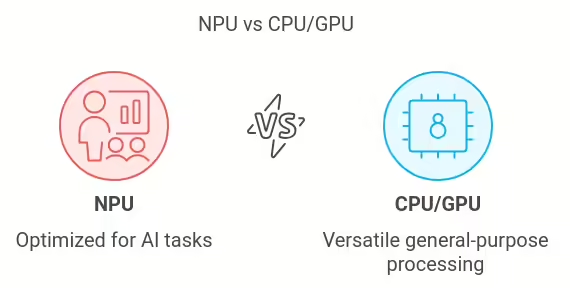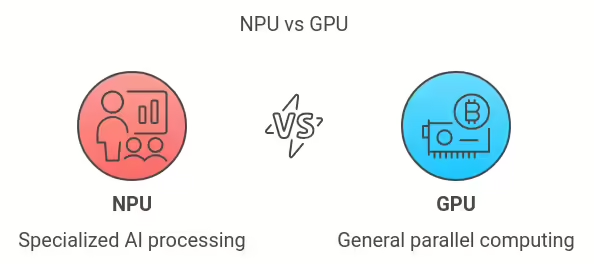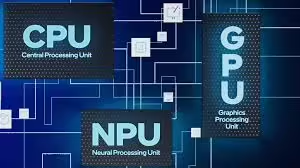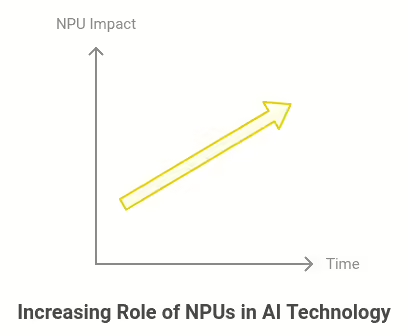When discussing hardware acceleration for AI workloads, both Neural Processing Units (NPUs) and Graphics Processing Units (GPUs) are leading technologies. However, the question of whether an NPU is better than a GPU depends on several factors, such as the specific workload, power efficiency, and the use case. Let’s explore the key differences and advantages of each to provide a clearer understanding.
What is NPU?
A Neural Processing Unit (NPU) is a specialized hardware designed specifically for accelerating machine learning (ML) tasks, particularly neural network inference.
Unlike general-purpose processors like CPUs and GPUs, which handle a wide variety of computing tasks, NPUs focus specifically on AI-driven operations, such as image and video processing, speech recognition, and object detection. They are highly optimized for parallel processing, which makes them more efficient for handling large volumes of data typically required for AI workloads.The neural processing unit handles sustained, heavily-used AI workloads at low power for greater efficiency.
What is a GPU?
A Graphics Processing Unit (GPU) is a versatile processor originally designed for rendering graphics but has found a significant role in AI and ML applications due to its ability to handle parallel processing tasks efficiently. GPUs are heavily used in training deep learning models because of their powerful cores and large memory bandwidth.
Key Differences Between NPU and GPU
-
Architecture and Design:
- NPU: Tailored for deep learning workloads, NPUs focus on optimizing neural network operations like matrix multiplications and convolutions. The architecture is specialized and streamlined, allowing for lower latency and higher efficiency during inference tasks. NPUs generally integrate well with AI frameworks, making them ideal for on-device AI processing.
- GPU: Designed with a broader scope, GPUs are built to handle a wide variety of parallel processing tasks, including graphics rendering and general-purpose computing tasks (GPGPU). This versatility makes them powerful for training complex models and performing tasks beyond just AI workloads.
-
Power Efficiency:
- NPU: NPUs are much more power-efficient compared to GPUs, especially in mobile and edge devices. Their specialization allows them to process AI tasks using minimal power, making them ideal for battery-powered devices like smartphones, IoT devices, or autonomous systems.
- GPU: While GPUs are powerful, they are power-hungry. In data centers or high-performance computing (HPC) environments, power consumption is less of a concern, but for mobile or edge applications, GPUs can be overkill and inefficient.
-
Performance for AI Tasks:
- NPU: NPUs excel in inference, which involves running trained AI models to make predictions. Their specialized architecture provides low-latency, real-time performance in edge devices, such as smart cameras, voice assistants, or autonomous drones.
- GPU: GPUs excel in both training and inference. Training deep learning models requires massive parallel processing and large memory capacity, where GPUs perform significantly better due to their large number of cores. However, for inference tasks, especially in power-constrained environments, GPUs are less efficient than NPUs.
-
Flexibility and Use Cases:
- NPU: NPUs are specialized for AI workloads and are not as flexible for general-purpose computing. They shine in specific applications where AI inference is the focus, but they lack the versatility to perform other computationally intensive tasks outside the realm of neural networks.
- GPU: GPUs are much more versatile, making them useful for a broader range of tasks, such as rendering graphics, gaming, scientific simulations, and deep learning. Their flexibility makes them the go-to choice in data centers for AI training and high-performance computing.
-
Cost and Scalability:
- NPU: NPUs tend to be more cost-effective in mass-market devices like smartphones or smart home devices, as they are designed to perform a specific set of tasks efficiently. However, scaling NPUs in data center environments for training massive models may not be practical.
- GPU: While GPUs can be more expensive, they are scalable and capable of handling a range of workloads, making them ideal for data center AI training tasks. Their cost is justified by their ability to serve multiple purposes and handle large-scale parallelism.

Is NPU Better than GPU?
It depends on the context:
-
For AI inference on edge devices: An NPU is generally better. Its specialization in neural network processing, combined with its low power consumption, makes it ideal for real-time AI tasks in smartphones, smart cameras, IoT devices, and more.
-
For AI training and versatile computing: A GPU is better. Its broader capabilities, powerful parallel processing, and ability to handle large-scale deep learning model training make it essential for data center environments and research applications.
Why NPUs Excel in AI Processing Efficiency
What sets NPUs apart from other types of processors is their ability to manage AI tasks without overburdening the CPU or GPU. While GPUs are known for their parallel computing capabilities, they often include circuits dedicated to graphics rendering, which makes them less specialized for AI compared to NPUs. NPUs are built solely for AI processing, freeing up other resources in the system for different tasks. This specialization allows them to perform AI tasks more efficiently and with lower power consumption, which is particularly beneficial in mobile devices and laptops where energy efficiency is crucial.

The Growing Presence of NPUs in Personal Computers
In the world of PCs, NPUs are becoming more common, particularly with new processors from Intel and AMD. These companies are integrating NPUs alongside CPUs and GPUs to enhance AI capabilities in personal computers. This means that tasks like background blurring during video calls or AI-enhanced image editing will run faster and more smoothly, without putting unnecessary strain on the main processor.

How NPUs are Revolutionizing Mobile Devices
Mobile devices are another key area where NPUs have made a significant impact. Companies like Apple and Huawei were early adopters, integrating NPUs into their smartphone processors to handle advanced camera functions, voice recognition, and other AI tasks. NPUs enable phones to quickly process things like facial recognition, image enhancement, and scene optimization without offloading the work to a cloud server, which also helps preserve user privacy.

The Expanding Role of NPUs in Modern Devices
NPUs are not just limited to computers and smartphones, though. They are increasingly being found in a wide range of devices, including smart TVs, cameras, and home automation gadgets. In these devices, NPUs help with tasks like upscaling video resolution, stabilizing images, and processing voice commands locally rather than relying on external servers.
Conclusion
Looking ahead, NPUs, are expected to play an even larger role as AI becomes more integrated into our everyday technology. With major tech companies incorporating NPUs into their hardware, consumers can expect faster, more efficient AI-driven features in their devices. Whether it’s speeding up video editing, improving AI filters in apps, or enhancing voice recognition, NPUs are paving the way for more intelligent and responsive devices. Ultimately, they represent a major step forward in making AI more accessible and powerful at the consumer level, enabling more sophisticated applications while improving system efficiency.

External Resources:
- All about neural processing units (NPUs) (NPU)
- What is an AI PC? (NPU)
- What Is a Neural Processing Unit (NPU)? (NPU)
